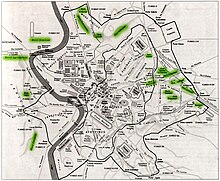Lovatelli urn
| Lovatelli urn | |
|---|---|
 | |
| Artist | Unknown |
| Year | 1st century BCE; (discovered 1875) |
| Type | Marble funerary urn |
| Dimensions | Height: 29.4 cm. Diameter: 32 cm. |
| Location | National Roman Museum at Palazzo Massimo, Rome |
The Lovatelli urn is a 1st century BCE marble funerary urn from the early Roman imperial period. It is thought to depict Persephone, Demeter and Triptolemus, the triad of the Eleusinian mysteries, however, there are several different competing interpretations about the figures and their meaning in the literature.
It was found during an 1875 excavation of the columbarium of the Statilii on the Esquiline Hill near Porta Maggiore in Rome, Italy.[1] This area contained the remains of freed slaves and servants of the family. The object is named after Ersilia Caetani Lovatelli, an Italian art historian and archaeologist who first published a description of it in 1896. It is held in the collection of the National Roman Museum.[2]
Background[]

The urn was discovered during the excavation of the columbarium of the Statilii family by Italian archaeologists Edoardo Brizio and Rodolfo Lanciani from 1875 to 1877.[3] They discovered three chamber tombs referred to as N, O, and P.
Description[]
The urn depicts three separate scenes, thought to portray a preliminary initiation and purification rite from the Lesser Eleusinian Mysteries, often described as myesis. The imagery is often compared and contrasted with the Torre Nova sarcophagus first identified by in 1910.[4]
See also[]
References[]
- ^ Bianchi, U. (1976). Iconography of Religions. Brill. pp. 28-29. ISBN 9789004044869
- ^ Long, C. R. (1987). The Twelve Gods of Greece and Rome. E.J. Brill. pp. 225-226. ISBN 9789004077164
- ^ Caetani-Lovatelli, E. (1896). "Di un vaso cinerario con rappresentanze relative ai misteri de Eleusi". Bullettino della commissione archaeologica comunale di Roma. (7): 5-18.
- ^ Clinton, K. "Stages of initiation in the Eleusinian and Samothracian Mysteries”, In Cosmopoulos, M. B. (ed.) (2003)[2005]. Greek Mysteries: The Archaeology and Ritual of Ancient Greek Secret Cults. Routledge. pp. 59-60. ISBN 9780415248730
Further reading[]
- Borbonus, D. (2014). Columbarium Tombs and Collective Identity in Augustan Rome. Cambridge University Press. ISBN 9781139867719.
- George, M. (2013). Roman Slavery and Roman Material Culture. University of Toronto Press. pp. 44–46. ISBN 9781442661004
- Mylonas, G. E. (1961). Eleusis and the Eleusinian Mysteries. Princeton University Press. ISBN 9781400877294
External links[]
- Funerary art
- 1st-century BC sculptures
- Collections of the National Roman Museum
- 1875 archaeological discoveries
- Archaeological discoveries in Italy
- Eleusinian Mysteries